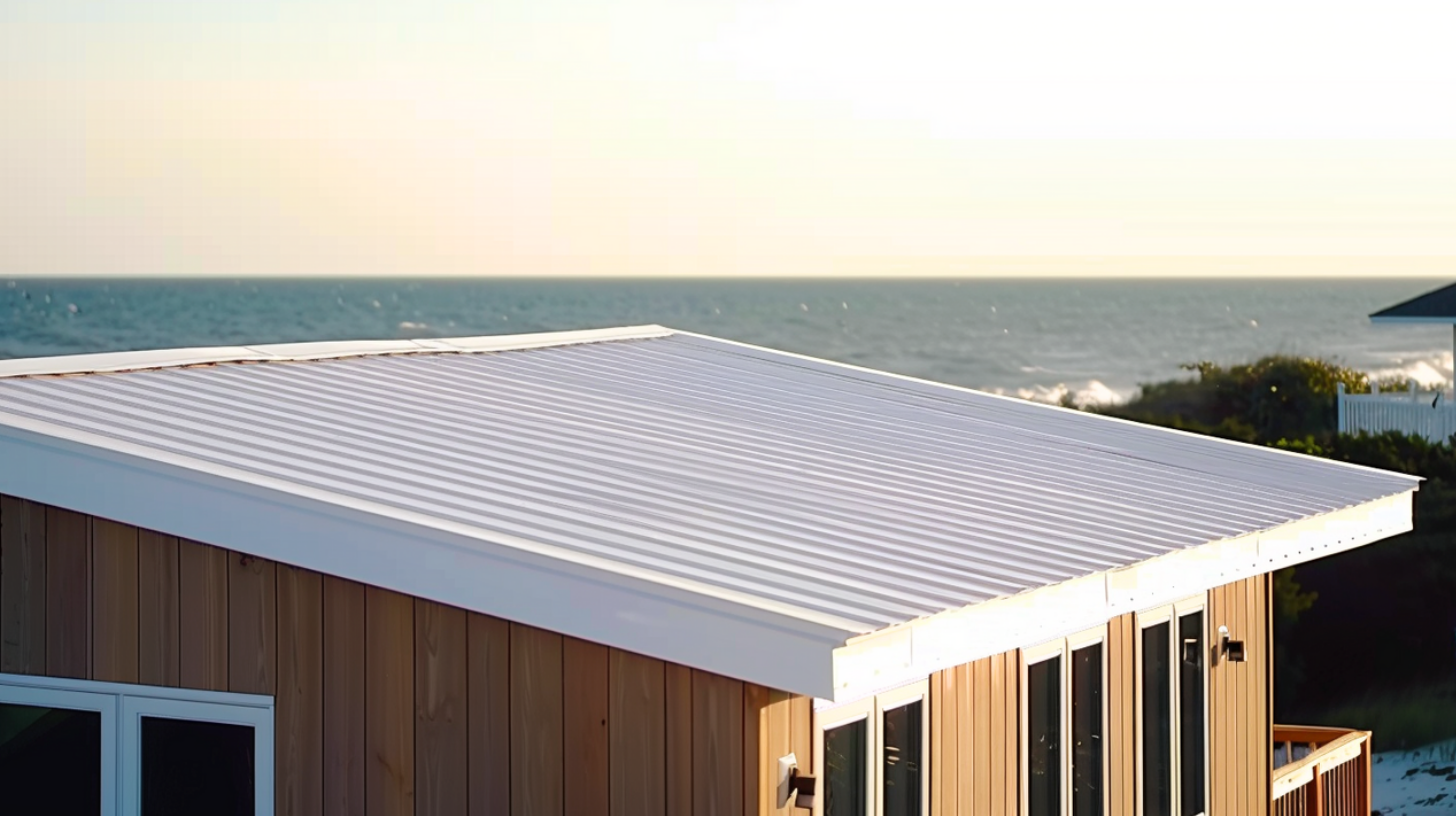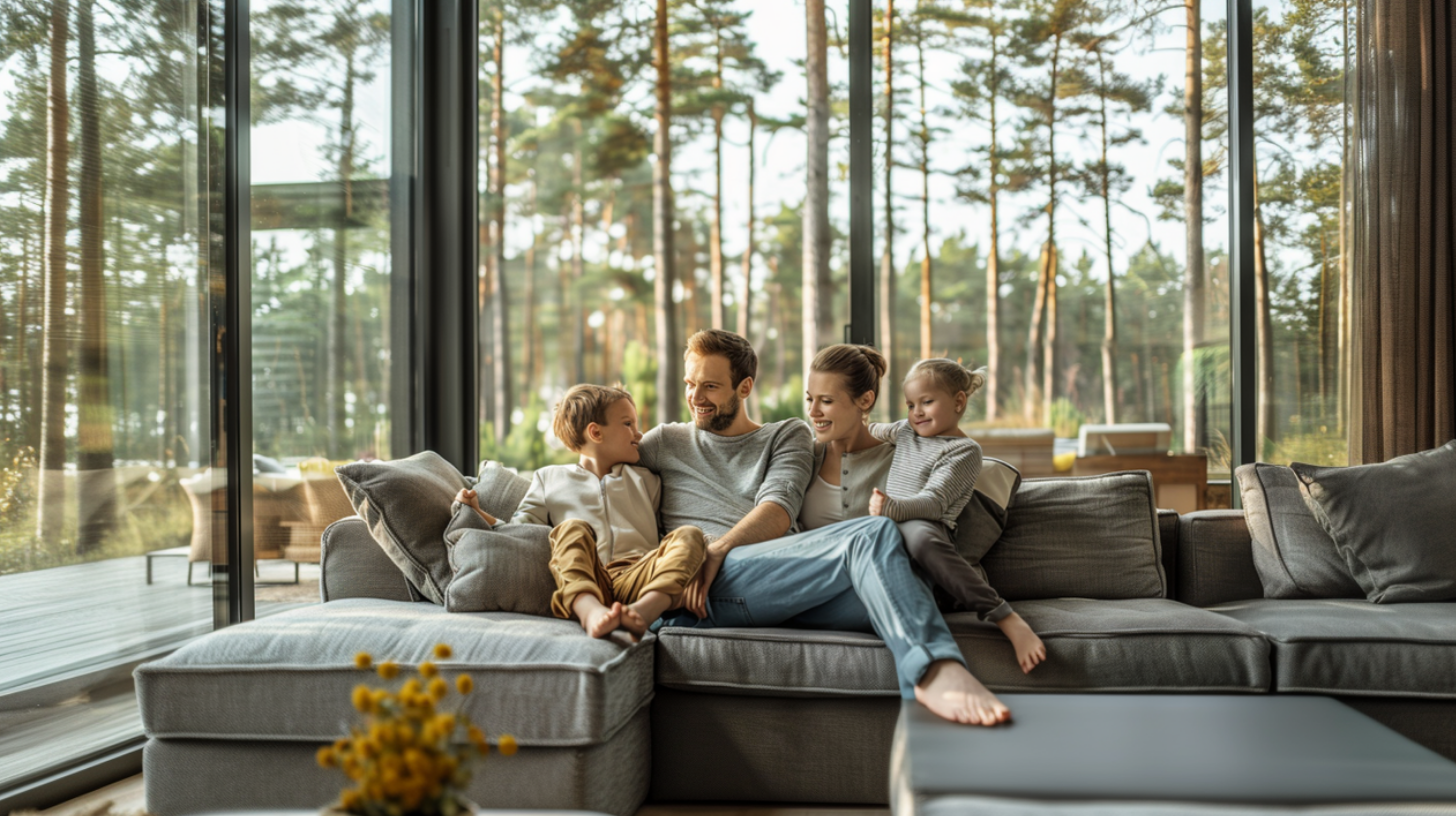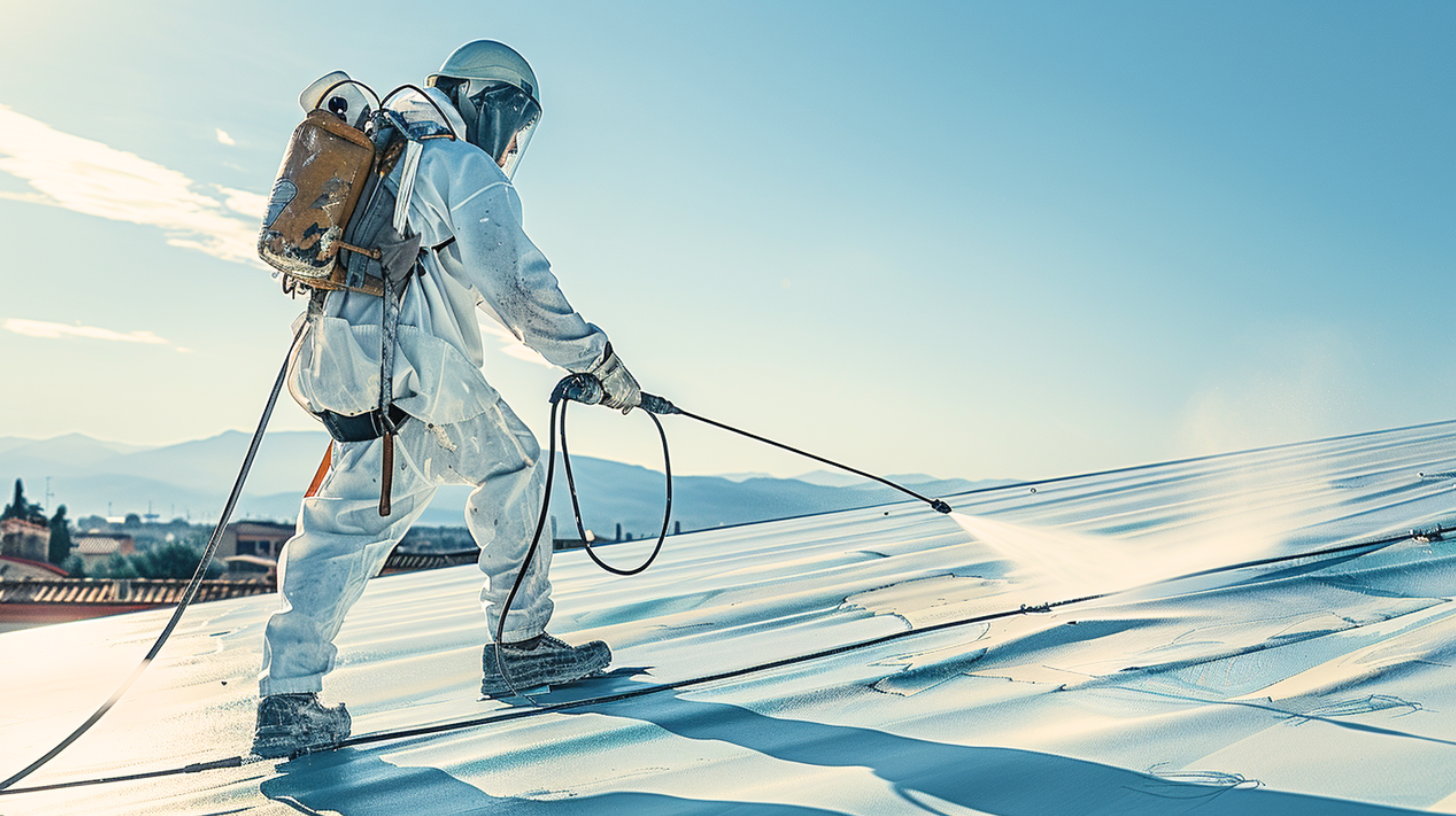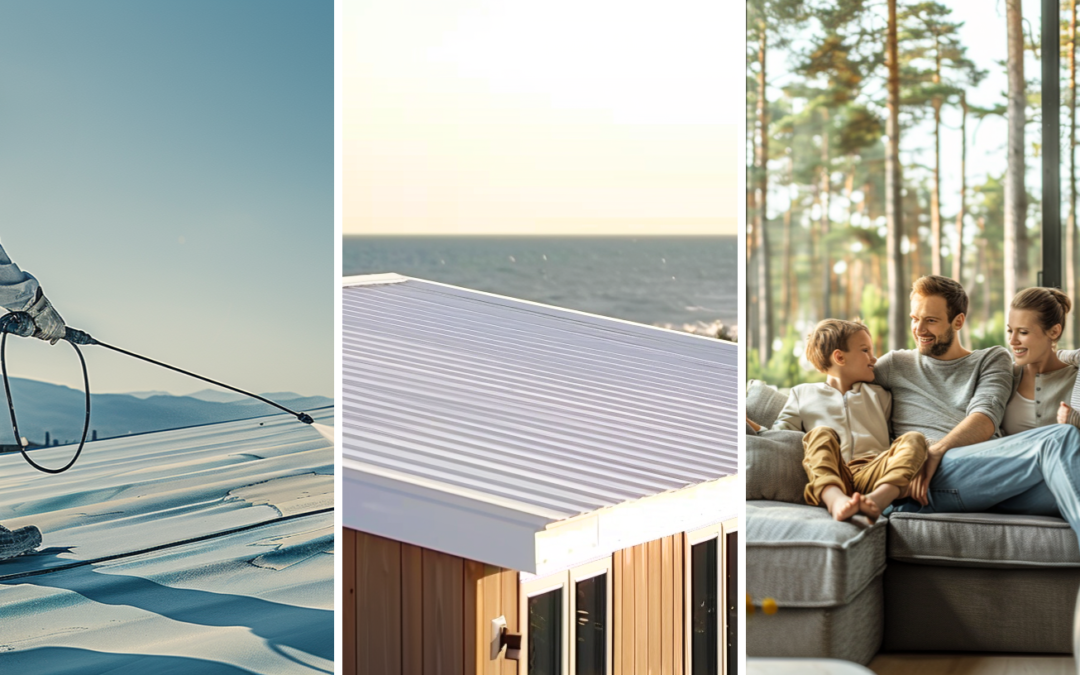What Are Cool Roofs?
The concept of cool roofs revolves around their ability to reflect sunlight (solar reflectance) and emit heat (thermal emittance) rather than absorb it. Cool roofs use light-colored materials or coatings, which reflect a significant portion of the sunlight that strikes them. This reflection prevents the roof from heating up and, in turn, reduces the amount of heat transferred into the building below.
The primary advantage of cool roofs is their ability to reduce a building’s overall heat buildup. This can lead to substantial energy savings by lessening the need for air conditioning and mitigating the strain on mechanical cooling systems. Additionally, cooler roofs contribute to a more comfortable indoor environment and extend the roof’s lifespan by preventing excessive heat-related damage.
By implementing cool roofs, homeowners and building owners can experience various benefits, including energy efficiency, reduced carbon footprint, and lower energy bills. Using light-colored materials and reflective coatings ensures that heat is reflected away from the structure, effectively cooling the building and making it a more sustainable and comfortable place to live or work.

Cool Roofs - Composition of Cool Roofs - Sky Roofing Construction & Remodeling
Composition of Cool Roofs
Cool roofs are popular for home and building owners who want to enhance energy efficiency and reduce cooling costs. These roofs use materials with special properties to reflect sunlight and minimize heat absorption. Common materials used in cool roofs include PVC, TPO, and EPDM.
PVC (polyvinyl chloride) is a thermoplastic cool roofing material that contains special pigments capable of reflecting sunlight. These pigments help reduce the heat transferred into the building, lowering energy consumption and cooling costs. Additionally, PVC roofs are known for their durability and resistance to weathering, making them an ideal choice for cool roofs.
TPO (thermoplastic olefin) is another cool roofing material commonly used in cool roof construction. It features reflective properties and flexibility, enabling it to adapt to different roof styles and structures. TPO roofs often include special pigments and additives that enhance their ability to reflect sunlight and prevent UV damage.
EPDM (ethylene propylene diene terpolymer) is a synthetic rubber cool roofing material used in cool roofs. It also contains special additives and pigments that help reflect sunlight and protect the roof membrane from harmful UV rays. EPDM roofs are known for their durability, low maintenance requirements, and resistance to extreme weather conditions.
These materials contribute to the energy efficiency and reduced cooling costs associated with cool roofs by adhering to cool roof standards, which ensure optimal solar reflectance and thermal emittance properties. Properly designed cool roofs reduce heat flow into buildings, maintaining a more consistent indoor temperature and reducing the need for excessive air conditioning.

Cool Roofs - Benefits of Cool Roofs - Sky Roofing Construction & Remodeling
Benefits of Cool Roofs
Energy Efficiency
One significant benefit of cool roofs is their energy efficiency. These roofs are designed to reflect more sunlight and absorb less heat than traditional roofs. As a result, they significantly reduce roof temperature, which leads to substantial cooling savings during the hot summer months. By keeping the building’s interior cooler, cool roofs lower the demand for air conditioning, ultimately leading to energy savings and reduced utility bills.
The cost savings associated with cool roofs are desirable for homeowners and building owners. With lower energy consumption, the money saved on cooling costs can quickly offset any additional expenses incurred during installation. Studies have shown that cool roofs can save up to 15% on cooling energy needs in hot climates. The reduced roof temperature can also result in less strain on HVAC systems, extending their lifespan and reducing maintenance costs.
While cool roofs are primarily known for their cooling savings, they can also impact heating energy needs. In colder climates, the reduced roof temperature may lead to slightly increased heating energy consumption during the winter. However, the overall energy savings and environmental benefits often outweigh these minor increases.
In addition to cost savings, cool roofs also contribute to a greener environment. Reducing energy consumption helps lower greenhouse gas emissions and mitigate the urban heat island effect, making cool roofs an environmentally friendly choice for those looking to impact the planet positively.
Environmental Impact
Cool roofs are particularly effective in regions that experience extreme temperatures. They keep buildings cooler in the summer and reduce the heat island effect, helping maintain more stable indoor temperatures, especially during heat waves.
Given these environmental benefits, the potential expansion of cool roofs in the global market is promising. If widely implemented, cool roofs could significantly reduce carbon dioxide emissions, mitigating the impact of climate change. Additionally, cool roofs offer economic benefits, such as energy cost savings for homeowners and building owners. While upfront costs may be slightly higher than traditional roofing materials, the long-term energy savings and reduced maintenance costs make cool roofs a wise investment.
Comfort and Health
In addition to improved indoor comfort, cool roofs also offer better air quality. Traditional roofs can contribute to the buildup of heat in urban areas, creating what is known as the “urban heat island effect.” This effect can contribute to higher levels of air pollutants and reduced air quality. Cool roofs help mitigate this effect by reflecting sunlight and reducing temperatures in urban areas, resulting in cleaner and healthier indoor spaces.

Cool Roofs - Cool Roofs Installation Process - Sky Roofing Construction & Remodeling
Cool Roofs Installation Process
Pre-installation Considerations
Another consideration is climate suitability. Cool roofs are especially effective in hot climates, where they can significantly reduce energy costs during the hot summer months. However, energy savings may be less substantial in colder climates, and additional heating energy might be required. Evaluating your specific climate and determining if a cool roof meets the cool roof standards is the most suitable option for your commercial roofing needs is crucial.
Additionally, it’s important to address potential issues such as algae or mold growth. While cool roofs are designed to be more resistant to these problems, proper maintenance and cleaning are still essential to prevent any issues from developing.
Despite these considerations, there are numerous advantages to installing a cool roof. One key advantage is lower energy costs in warmer climates, where a cool roof can help reduce the need for air conditioning and lower electricity bills. Additionally, many regions offer rebates and incentives for installing cool roofs, which can help offset the initial costs for commercial roof installations.
Furthermore, cool roofs can lead to HVAC equipment downsizing, as the reduced heat transfer through the roof means less energy is required for cooling in commercial settings. This downsizing can result in additional cost savings and improved efficiency for commercial buildings.
Lastly, cool roofs can have an extended lifetime compared to traditional roofs. A cool roof’s reflective surface helps dissipate heat, reducing the wear and tear caused by thermal cycling. This leads to a longer-lasting roof and potential savings on replacement or maintenance costs over time.
Installation Steps
1. Surface Preparation: Thoroughly clean the existing roof surface and remove debris, dirt, or loose materials. Repair any damages or leaks before proceeding further.
2. Cool Coatings: The next step is to apply cool coatings. Choose a high-quality, weather-resistant coating that meets cool roof standards. Apply the layer using a roller or sprayer, ensuring even coverage. Allow sufficient drying time as per the manufacturer’s instructions.
3. Reflective Membranes: Alternatively, you can install a reflective membrane on the roof. These membranes are typically made from durable materials like PVC or TPO. Consult a professional to determine the best membrane for your specific roof type.
4. Membrane Application: Apply the reflective membrane according to the manufacturer’s instructions, ensuring proper overlap and alignment. Secure the membrane in place with adhesives or heat welding techniques.
5. Final Inspections: Conduct thorough inspections to ensure everything is installed correctly and sealed once the installation is complete. Check for gaps, wrinkles, or loose areas affecting the roof’s effectiveness.
Installing cool roofs requires attention to detail and adherence to these steps. By following these guidelines and using cool coatings or membranes, homeowners and building owners can enjoy the benefits of cool roofs, including reduced energy consumption and increased comfort levels within their spaces.
Post-installation Care and Maintenance
Regular cleaning is essential to keeping the cool roof in good condition. This involves removing debris or dirt accumulated over time and preventing mold or algae growth. Homeowners should consult the contractor or manufacturer’s guidelines for the appropriate cleaning methods and frequency.
Checking for loose connections or damage is vital to maintaining cool roofs. This includes inspecting the seams, flashings, and edges to ensure they are tightly secured and intact. Any signs of damage should be addressed promptly to prevent further issues.
Proper ventilation is crucial for cool roofs to function effectively. It helps to reduce heat buildup and maintain the roof’s efficiency. Homeowners should ensure the ventilation system is clean and unobstructed for optimum performance. Following the contractor’s maintenance guidelines is highly recommended to ensure the proper care and performance of the cool roof.
Cost and ROI of Cool Roofs
Several factors determine the energy-cost savings achieved through cool roofs. Firstly, the climate plays a significant role, as cool roofs are most effective in hot climates. They can reduce air conditioning costs by reflecting sunlight and reducing heat absorption. Additionally, roof insulation is vital in maximizing energy savings by preventing heat transfer. Higher energy prices also contribute to more significant potential savings with cool roofs.
Moreover, there are various rebates and incentives available for cool roof owners. Many utilities and agencies offer financial incentives to encourage the adoption of energy-efficient roofing solutions. Furthermore, cool roofs can lead to savings on HVAC equipment, as the reduced heat transfer lessens the load on the cooling system. Additionally, the extended service life of the roof membrane resulting from reduced heat absorption can save on maintenance and replacement costs for cool roof owners.
Explore Cool Roof Solutions with Sky Roofing Construction & Remodeling
Cool roofs present a forward-thinking solution for homeowners and building owners aiming to reduce energy costs while enhancing environmental sustainability. Whether you want to improve energy efficiency, reduce cooling costs, or contribute to environmental sustainability, Sky Roofing Construction & Remodeling (https://skyroofingconstructiontx.com) is here to help. Contact us today at (210) 942-9797 to schedule a roofing consultation and explore how cool roofs can benefit your home or commercial building. Let us guide you through the process and make your roofing investment an innovative and sustainable choice.
Willis Vachon is a seasoned contributing writer for Sky Roofing Construction & Remodeling, specializing in the technical and safety aspects of roofing construction. With a keen eye for detail and a passion for ensuring quality and safety in every project, Willis provides valuable insights that help both professionals and homeowners make informed decisions about their roofing needs.

